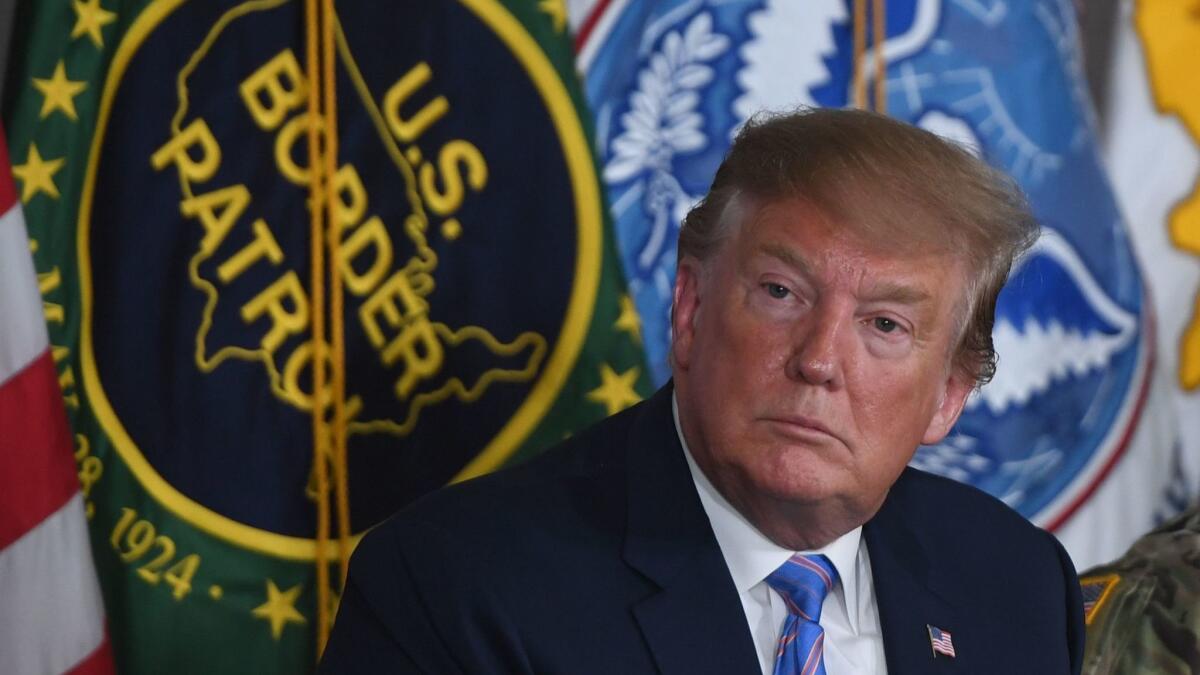Editorial: Trump’s newest asylum policy has the seed of a good idea buried amid bad ones

- Share via
President Trump’s new executive order for managing the tens of thousands of asylum seekers crossing the U.S.-Mexico border each month contains a germ of sense, but for the most part, like his earlier efforts, it is too harsh and fails to address the underlying problems that propel migration.
The order Trump gave to the Departments of Justice and Homeland Security on Monday lacks specifics but sets certain general rules. He wants the system sped up so that asylum cases are resolved within 180 days. That’s a good idea, if he can really accomplish it while respecting due process and reaching fair decisions. But he also wants to charge asylum seekers an application fee “not to exceed the costs of adjudicating the application” and he wants to bar temporary work permits for those who entered the country illegally. Those are punitive and counterproductive ideas.
There is no doubt that the U.S. faces a pressing problem at the border. In March alone, agents apprehended more than 100,000 people, up significantly from the average of nearly 64,000 over the previous five months. And more and more of them are requesting asylum when they arrive. Many of the asylum seekers probably don’t qualify for protection, which U.S. law and international agreements reserve for people facing persecution for their political or religious beliefs, their nationality or ethnicity, or because they belong to a particular social group targeted for repression. People fleeing street and gang crime generally fall outside the asylum criteria, as do those trying to escape poverty for a better standard of living.
Trump’s proposal to make asylum seekers pay an application fee runs counter to the notion of offering sanctuary to the desperate.
Under the current system, a migrant can cross into the United States legally or illegally and make an asylum request to a border agent. That leads to an interview with a trained immigration officer to determine whether the migrant has made a preliminary case for a “credible fear” of persecution. Those who do are referred to the immigration court system for hearings and decisions, a process that can take months or even years. During that time, most asylum seekers are not detained but are released into the country.
Of course the government should reach decisions as quickly as it can — that’s to everybody’s advantage. Fast decisions give resolution to the deserving rather than making them live in limbo, and also discourage long-shot requests by people whose requests are not merited.
But the immigration court system, which handles all immigration cases, has been overwhelmed for years. According to the Transactional Records Access Clearinghouse at Syracuse University, the current backlog stands at 869,000 cases; on average, those cases have been pending for 736 days. If the administration prioritizes asylum requests, by necessity non-asylum cases would be pushed back. Trump can’t fix any of that with a wave of the pen and an order to speed things up. The system needs many more judges and support staff, and more help for those requesting asylum to navigate the arcane system. That takes money, and Trump needs to work with Congress to expand the system’s capacity to meet the demand it faces. Above all, asylum seekers deserve due process and fair decisions.
Enter the Fray: First takes on the news of the minute »
Trump’s proposal to make asylum seekers pay an application fee runs counter to the notion of offering sanctuary to the desperate. Making people pay to exercise their right to seek help is cruel, and probably would lead to fewer applications by the poor, no matter how deserving they might be. It’s not much of an asylum system if it helps only those with money. Trump also wants to charge migrants fees to process applications for work permits, which would disadvantage those most desperate for the work. And he wants to bar work permits for asylum seekers who cross the border without permission between ports of entry, even though federal law allows anyone to enter the country anywhere and apply for asylum.
The latter policy would divide asylum seekers into classes. A migrant who wades across the Rio Grande and seeks out a border agent wouldn’t be entitled to a work permit; someone who enters on a tourist visa and applies for asylum would. That is fundamentally unfair. It’s also bad policy. If we allow people to remain in the country (while the courts, most likely, continue to take years to render a decision), wouldn’t we want those people to be able to support themselves in the meantime rather than becoming burdens on the state? Again, such a policy favors the wealthy over the poor.
The president is right when he says the immigration system is broken, but he has shown once again that he’s incapable of, or perhaps uninterested in, fixing it.
Follow the Opinion section on Twitter @latimesopinion or Facebook
More to Read
A cure for the common opinion
Get thought-provoking perspectives with our weekly newsletter.
You may occasionally receive promotional content from the Los Angeles Times.






